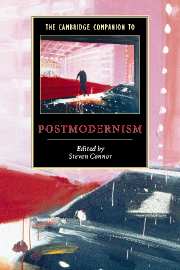Book contents
- Frontmatter
- Introduction
- 1 Postmodernism and philosophy
- 2 Postmodernism and film
- 3 Postmodernism and literature
- 4 Postmodernism and art
- 5 Postmodernism and performance
- 6 Postmodernism and space
- 7 Science, technology, and postmodernism
- 8 Postmodernism and post-religion
- 9 Postmodernism and ethics against the metaphysics of comprehension
- 10 Law and justice in postmodernity
- Further reading
- Index
- Sereis List
6 - Postmodernism and space
Published online by Cambridge University Press: 28 May 2006
- Frontmatter
- Introduction
- 1 Postmodernism and philosophy
- 2 Postmodernism and film
- 3 Postmodernism and literature
- 4 Postmodernism and art
- 5 Postmodernism and performance
- 6 Postmodernism and space
- 7 Science, technology, and postmodernism
- 8 Postmodernism and post-religion
- 9 Postmodernism and ethics against the metaphysics of comprehension
- 10 Law and justice in postmodernity
- Further reading
- Index
- Sereis List
Summary
The temporal line in the sand drawn between us and modernism by postmodernism's prefix is generally associated with a “crisis of historicity.” The withering away of the authority and certainty of our historical sense has another side, however: namely, the reaffirmation of our spatial imagination. This “spatial turn” has been variously avowed by many of our epoch's most illustrious intellectuals. Michel Foucault, for one example, insisted that “the anxiety of our era has to do fundamentally with space, no doubt a great deal more than with time. Time probably appears to us only as one of the various distributive operations that are possible for the elements that are spread out in space.” On the face of it, this statement looks willed and arbitrary, a mere inversion of Kantian categories for the purposes of polemic. We may do well to attend to John Frow's salutary suspicion that postmodernism designates “nothing more and nothing less than a genre of theoretical writing” in which the elaboration of strong oppositions is always the foundational gesture. Yet it is at least conceivable that we postmoderns live “more spatially” than the moderns, who somehow had it in them to live “more temporally” than we. The insistence of contemporary theory on this score is, arguably, not fanciful, but a response at the level of the concept to shifts in the structure of our world. This chapter explores that possibility by way of an historical presentation of reemergence of spatial consciousness in an escalating scale of magnitude, from the body, through the textures of everyday life, our cities, and ultimately to the planetary stage we are calling “globalization”; all of which are in fact inextricable - “postmodern space” being, precisely, their compression into a single, complex plane of immanence, whose contours and elevations we are still in the process of mapping.
- Type
- Chapter
- Information
- The Cambridge Companion to Postmodernism , pp. 116 - 135Publisher: Cambridge University PressPrint publication year: 2004
- 6
- Cited by



